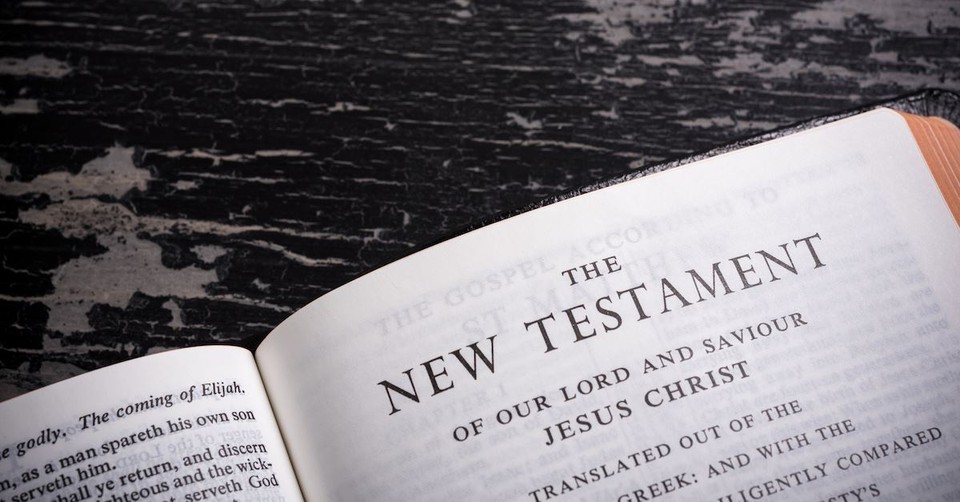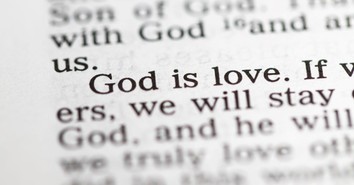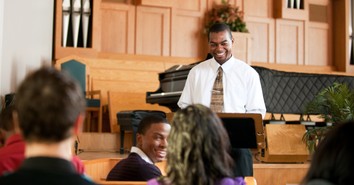How Do We Know the Right Books Made it into the New Testament?

“To rewrite the history books…Constantine commissioned and financed a new Bible, which omitted those gospels that spoke of Christ’s human traits and embellished those gospels that made Him godlike. The earlier gospels were outlawed, gathered up, and burned.”
This passage, from the bestselling Dan Brown novel The Da Vinci Code, expresses a common perspective in pop culture today: the Bible is a man-made book, collected by a corrupt church, in an effort to make their leader seem divine. But is this true? Has the New Testament, a collection of 27 books, been heavily edited and censored by the church? Do we have any reason to trust the books that were included? This article will explore these important questions.
What is the canon?
The word canon comes from the Greek kanon, and is derived from the Hebrew kaneh, or measuring rod. When applied to the Bible, the canon is the collection of books that are considered the inspired Word of God—the standard by which all theological claims should be measured.
While The Da Vinci Code is extremely inaccurate in its description of how the Bible was formed, it is correct in saying that the New Testament was not collected immediately after the resurrection of Jesus. Mostly, because the books were still being written.
Why was the canon formed?
The leaders of the early church recognized the importance of determining the biblical canon. The first reason they made the canon a priority was because they needed a standard—a “measuring rod”—by which they could recognize and reject heretical teaching by fringe leaders in the church. The most prominent early challenger to established doctrine was named Marcion. He viewed the God of the Old Testament as inferior to the Father revealed by Jesus. So he discounted the entire Old Testament, as well as books he viewed as tainted with Jewish teaching. Marcion declared his own piecemeal version of the canon in 135 A.D., prompting the church to respond. His beliefs were condemned and he was excommunicated in 144 A.D. His was the first of many other heretical movements to which the church responded.
A second reason the church was motivated to fix the canon of Scripture was due to the intense persecution being faced by Christians. The persecution by the Emperor Diocletian at the beginning of the fourth century was especially motivating, as he ordered the destruction of Christian writings. So it was vital that the church form a canon in order to stabilize the church and prevent the loss of Scripture. Believers needed to know which books they could hand over to the Roman authorities without committing the sin of sacrilege, and which were part of the canon—and, therefore, worth dying for.
The process of canonization.
It is important to note that history does not report all of the details of how the canon was established. The events surrounding this process happened centuries ago, in a time of intense persecution. Fortunately, the records that were preserved give insights into some of the contributing factors that influenced the formation of the New Testament.
One further caveat must be made before the criteria are discussed. The early church was adamant that they were attempting to recognize the books which had the authority of Scripture, not to impose their own authority upon them. They were not arbitrarily picking the books they liked the most, but rather they were acknowledging those works that already had the qualities of divine inspiration.
What criteria were used?
Apostolic Authority – The primary criterion for acceptance into the canon was authorship by an apostle. Additionally, books whose author had a close association with an apostle, such as Mark with Peter and Luke with Paul, were seen as authorized by them and were thus accepted. This authorship or authorization was not a necessary component, as a few non-apostolic scriptures were accepted, but it was the most prominent.
The Rule of Faith – Early church fathers like Irenaeus pointed to “the rule of faith” as a criterion which distinguished true teachings from the false ones being presented by heretics like the Gnostics. This meant that the church had been preaching the same message since the apostles—and really since Jesus. This is in line with what Paul taught in Galatians 1:8 when he said, “But even if we or an angel from heaven should proclaim to you a gospel contrary to what we proclaimed to you, let that one be accursed!” So teachings must align with the tradition of what was taught by Jesus, communicated by the apostles, and contained in the Old Testament.
Contrast this with the Gnostics, a group that claimed to have secret knowledge revealed to them about the evil of the physical world, which had no historical claim of tradition. They were simply creating something new, and so they and their writings were rejected.
Tertullian, another early church leader, likewise viewed tradition as vital in the interpretation of Scripture. Although controversy over some passages was inevitable, and heretics could twist the meaning of verses by taking them out of context, tradition would lead to the right interpretation. An example of a book that was accepted because of its conformity to the rule of faith is Hebrews. Although its authorship is unknown, its message faithfully aligns with the Old Testament and shows how Jesus fulfilled biblical prophecies.
Continued Church Use – The final test is whether the book continued to be acknowledged and used by the church at large. Although this criterion could be criticized as a simple majority opinion, it could also point to the Christian belief that God would guide the church into truth. In reality, it is incredible there was such a firm consensus amongst diverse groups of Christians across such a wide geographical area. Therefore, if a writing stood the test of time and continued to be used widely by the church, it retained its standing.
The earliest lists.
By the end of the first century, two-thirds of the books in today’s New Testament canon had been extensively circulated and were considered authoritative. The rest of them were referenced and thought by many to be inspired. However, some books took longer to be accepted by everyone. For example, Hebrews and 2 Peter were delayed because their authorship was disputed. Another example, Revelation was held up because it was not as widely known in some areas (which makes practical sense as it was the last to be written).
An early record was the Muratorian Fragment, a partially preserved ancient document written in about 175 A.D. It lists 23 out of the 27 New Testament books as authoritative, as well as a few others. It also rejects some spurious letters attributed to the apostle Paul—perhaps the false ones Paul himself referenced in 2 Thessalonians 2:2. The first document that includes all 27 books of the New Testament as the only canonical books was written by Athanasius, the bishop of Alexandria, in 367 A.D., followed by Jerome and Augustine soon after.
There were also some books that were defended by some of the early church leaders, but they were eventually rejected by the church as a whole. These include the first and second letters of Clement, the letter of Barnabas, the Shepherd of Hermas, and the Didache. Eventually these books were disqualified from the canon because they failed to meet the criteria mentioned above.
So it wasn’t one unanimous decision?
The canon was not fixed by an instantaneous decision, but through a process over the course of many years. On one hand, this could be seen as a weakness of the Bible. If the books were supposed to be divinely inspired, why did it take the church so long to confirm them? On the other hand, it points to the meticulous care the early church took to make sure they got it right. Rather than rushing to accept whatever writings they had or looking to a single leader to declare the list of officially sanctioned documents, they allowed processes to work gradually while trusting that God was guiding them.
This extended process also refutes some of the claims made in pop culture about the Bible. As mentioned in the quote at the beginning of this article, Dan Brown’s The DaVinci Code (which, incredibly, claims in its opening pages to be historically accurate) declares that the books of the Bible were conspiratorially decided at the council of Nicaea, with the unwanted books being burned.
Shockingly, this claim is actually true—but not for the Bible. Instead, according to Muslim sources, this is what happened to the Quran. In the seventh century, the khalifa Uthman rounded up all of the divergent copies of the Quran, selected the one he preferred, and burned the rest. Although an efficient way of eliminating competing collections of the sayings of Mohammad, of which there were many, it does not inspire confidence that the current version matches the original.
In contrast, Brown’s claim about the New Testament is completely false. The canon was virtually established through the processes described above at least 150 years prior to Constantine. Although the final and “official” ratification of canon came a few decades after Constantine at the Council of Hippo in 393 A.D., there is no historical reason to believe Constantine was personally involved in this process.
What about the Gnostic gospels?
What should we think about the “gnostic gospels,” such as the Gospel of Phillip, the Gospel of Mary, or the Gospel of Thomas? Again, Dan Brown claims they were written earlier than the four canonical gospels in the New Testament. So why weren’t they included in the canon?
First, they were actually written much later, in the late second and third centuries—far too late to have any association with the real apostles of Christ. In contrast, the academic consensus is that the four canonical gospels—Matthew, Mark, Luke, and John—were all written within the first century, which is well within the lifetimes of the apostles.
Second, the Gnostic gospels did not adhere to the rule of faith. For instance, the Gospel of Thomas includes bizarre ideas such as men becoming lions if they eat them and other teachings that contradict what Christians had been teaching for a century. Third, though they were later favored by a few outliers, they never entered into widespread use in the early churches. The gnostic gospels failed all three criterions for inclusion, and were, therefore, never recognized as being canonical.
Because of the Holy Spirit, we can be confident in the canon.
Like most episodes of ancient history, the facts concerning the formation of the canon have not been recorded in their entirety. Some details remain hidden and some challenges can still be raised. However, the early agreement among church leaders and the rigorous criteria applied to canonical candidates help alleviate most of those concerns.
Additionally, Jesus promised in John 14:26 that the Holy Spirit “…will teach you everything, and remind you of all that I have said to you.” Christians believe that the Holy Spirit was responsible not only for inspiring the authors of the New Testament books, but also guiding the church fathers to recognize them in the canon. This final factor should give objective observers confidence that the right books were accepted, and that the Bible we have today is the complete, inspired Word of God.

Matthew received his Certificate of Theological Studies from Wycliffe Hall and was trained at the Oxford Centre for Christian Apologetics. He has spoken at universities, churches, societies, and training events, and has led international missions trips in Europe and Asia. He’s passionate about helping people understand that faith in God makes sense, removing barriers to belief, and personally introducing others to Jesus.
Consulted or Quoted Sources:
Abu Abdullāh Muhammad Ibn Ismā`īl al-Bukhārī, Sahih Bukhari. Volume 6, Book 61, Number 510. Published 854 A.D.
Brown, Dan. The DaVinci Code. New York, NY: Doubleday, 2003.
Brown, Harold O.J. Heresies. Peabody, MA: Hendrickson, 1988.
Bruce, F. F. The New Testament Documents, Are They Reliable? 5th ed. Grand Rapids, MI: Eerdmans, 1960.
Comfort, Philip W. and Jason Driesbach. The many gospels of Jesus. Carol Stream, IL: Tyndale House Publishers, 2008.
Horton, David. The Portable Seminary. Bloomington, MN: Bethany House Publishers, 2006.
Geisler, Norman L. and William E. Nix. From God to us. Chicago, IL: Moody Publishers, 2012.
Lutzer, Erwin. The DaVinci Deception. Carol Stream, IL: Tyndale House Publishers, 2006.
McGrath, Alister E. Christian Theology: An Introduction. 5th ed. New York: Wiley-Blackwell, 2011.
Metzger, Bruce. The New Testament, its background, growth, and content, 2nd ed. Nashville, TN: Abingdon Press, 1983.
Miller, Robert J. The complete gospels: annotated scholars version. Santa Rosa, CA: Polebridge Press, 1994.
Noll, Mark A. Turning points: Decisive moments in the history of Christianity, 3rd ed. Grand Rapids, MI: Baker Books, 2012.
Shelley, Bruce L. Church history in plain language (3rd ed.). Nashville, TN: Thomas Nelson, 2008.
Strobel, Lee. The case for Christianity answer book. Grand Rapids, MI: Zondervan, 2014.
Strobel, Lee & Garry Poole. Exploring the DaVinci code. Grand Rapids, MI: Zondervan, 2006.
Witherington, Ben III.The Gospel code. Westmont, IL: InterVarsity Press, 2004.
Photo credit: ©Thinkstock/Jaflippo
Originally published October 12, 2018.





